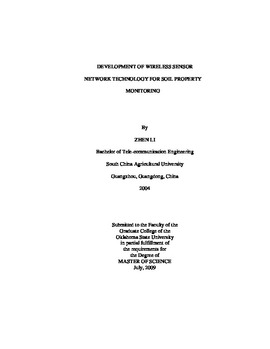| dc.contributor.advisor | Wang, Ning | |
| dc.contributor.author | Li, Zhen | |
| dc.date.accessioned | 2014-02-25T00:20:57Z | |
| dc.date.available | 2014-02-25T00:20:57Z | |
| dc.date.issued | 2009-07-01 | |
| dc.identifier.uri | https://hdl.handle.net/11244/7950 | |
| dc.description.abstract | In the first part of this thesis, we designed and developed a soil property monitoring system with two generation evolutions. Soil property parameter data including soil moisture, soil electrical conductivity and near-surface soil temperature were collected from using two kinds of sensors embedded in four different depths as 50.8, 152.4, 304.8 and 609.6mm underground. A hybrid sensor network (HSN) conceptual system module including in-field wireless sensor network, cellular network and the Internet was put forward and realized for transmitting in-field data to the lab infrastructure. Results from the first part of the thesis indicated that wireless sensor network technologies had considerable advantages in field data collection and transmission over the traditional invasive methods. System quality of service testing results as: the average packet delivery rate and in-field data error rate were 95.05% and 0% until day of test while the averaged valid data rate was above 97% in general for each node. In the second part of this thesis, outdoor as well as off-line laboratory statistical experiments were carried out for analyzing impacts of impact factors as plant height, antenna gain, transmitter & receiver height, and separation distance to in-field radio propagation and modeling radio wave path loss to make the communication performance predictable. The experiments were divided into three blocks by two plant heights as 0.05m and 0.4m. Three widely used path loss models as COST-Hata, free space and plane earth models were included for verifying their applicability for in-field scenarios. Multi-variable linear regression was applied for relating the path loss to the impact factors. Results from the second part of the thesis indicated that the blocking criteria selection was proper and the Fresnel clearance dominated the in-field radio wave attenuation while the influence of reflection patterns was non-ignorable. R2 for the four regressed path loss prediction model was 0.822, 0.810, 0.843, and 0.899, respectively. By comparing measured path loss to predicted ones using general and regressed models, COST-Hata model yielded the highest difference, free space model yielded the second highest difference, and specific regressed models generated the least difference in most cases. A threshold of 70m was obtained for reliable communication in the worst cases of our experimental scenarios. | |
| dc.format | application/pdf | |
| dc.language | en_US | |
| dc.publisher | Oklahoma State University | |
| dc.rights | Copyright is held by the author who has granted the Oklahoma State University Library the non-exclusive right to share this material in its institutional repository. Contact Digital Library Services at lib-dls@okstate.edu or 405-744-9161 for the permission policy on the use, reproduction or distribution of this material. | |
| dc.title | Development of Wireless Sensor Network Technology for Soil Property Monitoring | |
| dc.type | text | |
| dc.contributor.committeeMember | Solie, John | |
| dc.contributor.committeeMember | Taylor, Randy | |
| dc.contributor.committeeMember | Weckler, Paul | |
| osu.filename | Li_okstate_0664M_10477.pdf | |
| osu.college | Engineering, Architecture, and Technology | |
| osu.accesstype | Open Access | |
| dc.description.department | Biosystems and Agricultural Engineering | |
| dc.type.genre | Thesis | |
